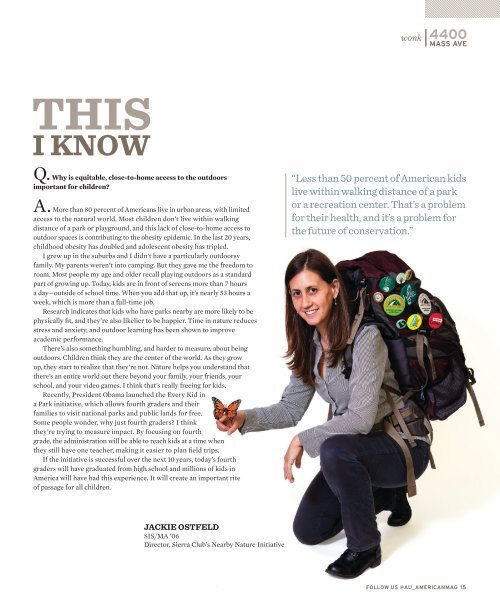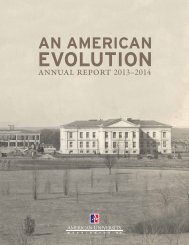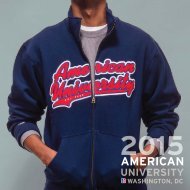American Magazine, July 2015
This issue, meet Maryland First Lady Yumi Hogan, learn about Kogod’s startup incubator, explore the Smithsonian’s new American Enterprise exhibit, hop on the Metro to Navy Yard—Ballpark, and get to know some of AU’s 1,200 Atlanta transplants. Also in the August issue: footwear on campus, 12 Eagles to follow on Twitter, and a new quiz with a tasty prize.
This issue, meet Maryland First Lady Yumi Hogan, learn about Kogod’s startup incubator, explore the Smithsonian’s new American Enterprise exhibit, hop on the Metro to Navy Yard—Ballpark, and get to know some of AU’s 1,200 Atlanta transplants. Also in the August issue: footwear on campus, 12 Eagles to follow on Twitter, and a new quiz with a tasty prize.
Create successful ePaper yourself
Turn your PDF publications into a flip-book with our unique Google optimized e-Paper software.
wonk<br />
Q. Why is equitable, close-to-home access to the outdoors<br />
important for children?<br />
A. More than 80 percent of <strong>American</strong>s live in urban areas, with limited<br />
access to the natural world. Most children don’t live within walking<br />
distance of a park or playground, and this lack of close-to-home access to<br />
outdoor spaces is contributing to the obesity epidemic. In the last 20 years,<br />
childhood obesity has doubled and adolescent obesity has tripled.<br />
I grew up in the suburbs and I didn’t have a particularly outdoorsy<br />
family. My parents weren’t into camping. But they gave me the freedom to<br />
roam. Most people my age and older recall playing outdoors as a standard<br />
part of growing up. Today, kids are in front of screens more than 7 hours<br />
a day—outside of school time. When you add that up, it’s nearly 53 hours a<br />
week, which is more than a full-time job.<br />
Research indicates that kids who have parks nearby are more likely to be<br />
physically fit, and they’re also likelier to be happier. Time in nature reduces<br />
stress and anxiety, and outdoor learning has been shown to improve<br />
academic performance.<br />
There’s also something humbling, and harder to measure, about being<br />
outdoors. Children think they are the center of the world. As they grow<br />
up, they start to realize that they’re not. Nature helps you understand that<br />
there’s an entire world out there beyond your family, your friends, your<br />
school, and your video games. I think that’s really freeing for kids.<br />
Recently, President Obama launched the Every Kid in<br />
a Park initiative, which allows fourth graders and their<br />
families to visit national parks and public lands for free.<br />
Some people wonder, why just fourth graders? I think<br />
they’re trying to measure impact. By focusing on fourth<br />
grade, the administration will be able to reach kids at a time when<br />
they still have one teacher, making it easier to plan field trips.<br />
If the initiative is successful over the next 10 years, today’s fourth<br />
graders will have graduated from high school and millions of kids in<br />
America will have had this experience. It will create an important rite<br />
of passage for all children.<br />
“Less than 50 percent of <strong>American</strong> kids<br />
live within walking distance of a park<br />
or a recreation center. That’s a problem<br />
for their health, and it’s a problem for<br />
the future of conservation.”<br />
JACKIE OSTFELD<br />
SIS/MA ’06<br />
Director, Sierra Club’s Nearby Nature Initiative<br />
FOLLOW US @AU_AMERICANMAG 15

















